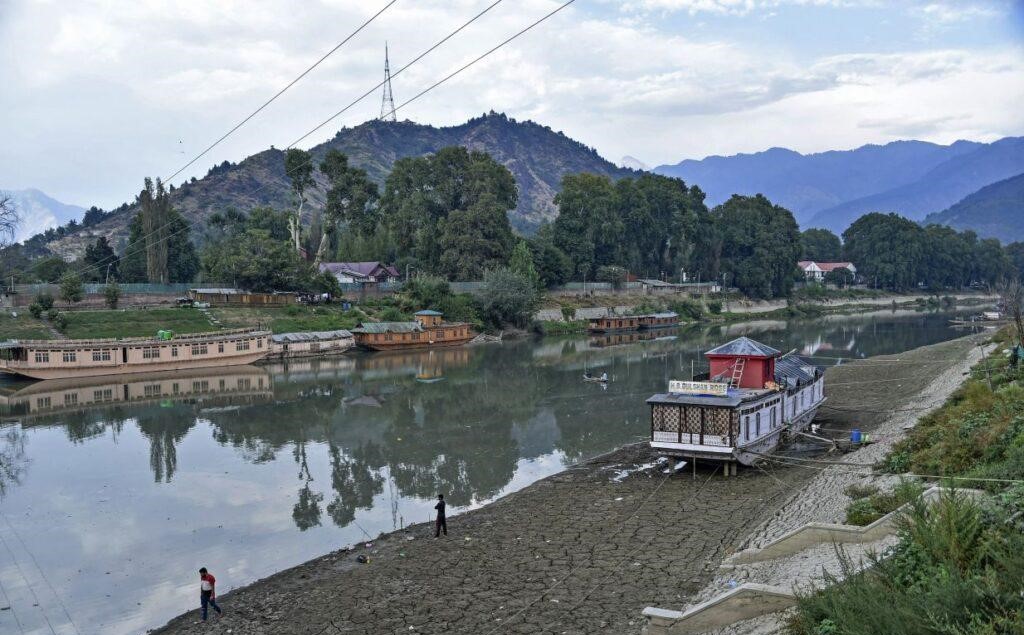Kashmir’s Water Crisis Deepens Amid Scorching Heatwave
By: Javid Amin | Srinagar | 03 July 2025
The Valley’s Drying Heart
Kashmir is enduring an unprecedented water emergency. June 2025 was the hottest month since 1978, with temperatures in Srinagar peaking at 35.5°C—even hotter than summer days in Jammu. This extreme heat, worsened by mounting climate change, has triggered widespread drying of streams, shriveled glaciers, and a perfect storm that leaves both urban taps and rural wells dangerously empty.
In weaving this comprehensive exposé, we uncover:
-
The environmental story behind the numbers
-
Deep personal impacts on farmers, urban families, and apple growers
-
Which solutions are proving effective—and which fall painfully short
-
The pressing question: What must be done now—before it’s too late?
What’s Fueling the Crisis?
01 Record-Breaking Heat
June 2025 shattered records, with daily highs 5–7°C above the monthly average. Extended heatwaves are intensifying evaporation, drying soils and fresh water bodies at a terrifying rate.
02 Vanishing Snowpack
Last winter saw a 38% drop in snowfall, critically reducing glacier reserves that feed streams every summer. Without this natural water tank, rivers and irrigation networks are failing.
03 Evaporating Streams
Traditional tributaries like the Lal Koul and Ferozpura Nallah have nearly vanished. Over 40,000 kanals of farmland are now without access to irrigation.
04 Urban Water Scarcity
In Srinagar, municipal water is supplied for only 30 minutes daily. The Kashmir Jal Shakti Department is relying heavily on emergency trucks to meet demand, seriously straining resources.
Impact on Agriculture & Livelihoods
01 Paddy Collapse
Major paddy zones in Sopore, Budgam, and Anantnag are barren as crops wilt. Many farmers, facing steep losses, haven’t even sown.
02 Apple Orchard Damage
Kashmir’s iconic ₹8,000 crore apple economy is reeling. Heat stress and inadequate water are reducing fruit size and sweetness, threatening quality and harvest yields.
03 Groundwater Depletion
As surface water vanishes, both rural and urban residents are relying on groundwater—dropping levels by as much as 4–6 meters in Srinagar and Pulwama, risking long-term sustainability.
Response & Relief: Too Little, Too Late?
01 Government Actions
The Department of Jal Shakti has increased tanker services, promises emergency pipeline extensions, but admits infrastructure is “critically overstretched.”
02 Farmer Demands
Agricultural communities are calling for:
-
-
Immediate audits of irrigation networks
-
Fast installation of pumps and pipelines
-
Compensation for crop failure and lack of sowing
-
03 Rain Forecast: Sudden Hope?
Meteorologists predict brief rainfall from July 5–7. But as officials warn, the window for saving crops has already closed, especially for paddy.
Voices from the Valley
“In my 60 years, I’ve never seen anything like this. No help, no water. We are at the end of our hope.” — Farmer, Sagipora
“We’re stuck between repaying loans and feeding our children.” — Farmer, Zaloora
Urban residents echo similar fears: “We collect water in buckets every night just to cook and wash,” says a Srinagar homemaker.
Beyond the Obvious: The Hidden Costs
01 Health Risks from Polluted Water
Rationed supply means many now consume unsafe, unfiltered water from makeshift borewells—headaches, dysentery, and gastrointestinal infections have surged.
02 Economic Fallout
Already fragile incomes face added expenses: ₹4,000–₹6,000 per tanker, declining produce sales, and escalating loan burdens from failed crops.
03 Environmental Degradation
Lower water tables trigger soil erosion, destabilize slopes, and threaten long-term ecological balance—dark signals of desertification.
What’s Missing: Gaps in the Response
01 Lack of Real-Time Monitoring
No statewide water dashboard to track stream levels, groundwater conditions, or grievance redress—leaving villagers blind to crises and delays.
02 Inadequate Outreach
Multiple uncoordinated efforts by departments (agriculture, irrigation, Jal Shakti) result in muddled service delivery and lost entitlements.
03 Infrastructure Loopholes
Water pipelines are outdated or missing in key zones, especially in rural Baramulla and old Srinagar neighborhoods.
04 Climate Disruption Ignored
Despite warnings, state policies lack long-term adaptation any drought or heat waves—risks are treated as temporary, not structural.
Sustainable Solutions & Forward Steps
01 Rainwater Harvesting Systems
Village-level tanks, school roof gutters, and public buildings can capture rainfall—building resilience against dry spells.
02 Solar-Powered Tube Wells
Affordable, durable solutions that reduce dependence on power—and groundwater depletion.
03 Drip Irrigation & Mulching
Efficient water use can increase yield per drop, helping farmers cope with shortages.
04 Watershed Management
Landscape-level planning for infiltration trenches, check dams, and rejuvenation of age-old karezes (underground water tunnels).
05 Public Awareness Campaigns
Kashmiris must be educated on water conservation, safe storage, reuse, and protection from contamination.
Lessons from Other Valleys
-
Himachal Pradesh’s micro-watershed success in drought recovery
-
Israel’s drip irrigation model useful for apple orchards
-
Australian community rainwater farms that revive groundwater
State-level adaptation with local adaptation is critical for long-term resilience.
National Responsibility: Turning Crisis into Priority
-
The Center must declare a ‘National Drought Emergency’ for Kashmir.
-
The Jal Shakti Ministry should offer emergency funds and technical support.
-
Inclusion in PMKSY and MGNREGA watershed programs.
-
External funding from international climate adaptation funds for public water infrastructure.
The Big Picture: Climate Signal or Policy Failure?
This crisis is both a symptom of global warming and regional policy neglect. Without structural reforms, extreme weather events will overwhelm Kashmir’s capacity to adapt.
Conclusion: Crisis Today, Change Tomorrow
Kashmir’s water emergency is more than a broken tap—it’s a broken system, requiring both immediate relief and long-term climate resilience.
Kashmiris deserve cleaner taps, greener fields, and a future that isn’t washed away by the next heatwave.
Summary Box
| Crisis Element | Immediate Impact | Long-Term Risk |
|---|---|---|
| Heatwave | Evaporated surface water | Desertification |
| Snow Deficit | Reduced streamflow | Glacial retreat |
| Urban Shortage | Daily ration | Groundwater collapse |
| Agriculture Loss | Failed crops | Livelihood migration |
| Public Health | Unsafe water | Disease outbreak |



